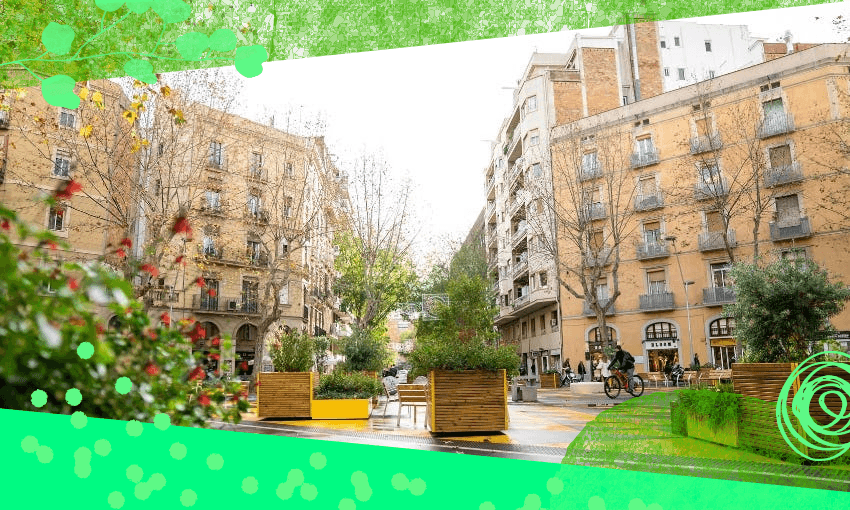Barcelona’s city streets have gone from traffic-clogged to pedestrian-friendly. How? Superblocks. Ellen Rykers explains.
This is an excerpt from our weekly environmental newsletter Future Proof. Sign up here.
Last week I read a great interview with renowned urbanist Janette Sadik-Khan by The Spinoff’s Wellington editor Joel MacManus: “You can reimagine streets, you can redesign them, and repurpose them to meet the needs of today, not the culture of 60 years ago,” Sadik-Khan said.
Barcelona has found a way to reimagine its streets: superblocks. The city’s director of urban ecology, Salvador Rueda, recently visited New Zealand to discuss the superblock concept he’s spearheaded in a city that was once one of the most noisy and traffic-heavy in Europe.
What is a superblock?
A superblock groups together multiple smaller city blocks, often a 3×3 grid. On the streets inside the superblock, through-traffic is restricted. Cars can still enter – but they’re speed-limited and must yield to pedestrians. “It’s stupid to go in if your destination is not inside,” Rueda explains. This opens up the street space for other things – people walking and cycling, al fresco dining, and more greenery.
The idea is to rebalance transportation modes and use of street space, so it’s not solely focused on cars. “The city is like a paella. It is a system of proportions. But if you put so much salt, you can’t eat it. If you put so many cars, it’s not digestible,” says Rueda. “Cities must be for citizens, not cars.”
Superblocks are possible even in cities that don’t feature a grid structure – and they could be possible in New Zealand too: Rueda suggests Auckland’s Wynyard Quarter as an ideal place to start.
Barcelona’s superblocks pave the way
The Catalan city began pursuing the superblock concept in 2016, constructing the Poblenou superilla in 2017. A handful more have sprung up since, with plans to eventually transform the urban landscape with 503 superilles by 2030. So far, results are promising. In the Sant Antoni superblock, air quality improved and noise dropped by 4 decibels. Residents’ wellbeing has improved too: people report feeling more tranquillity, safety and satisfaction.
And while traffic reduced on the superblock’s interior streets, it wasn’t simply displaced to the perimeter – people chose not to use cars so much. “The most important network in our sites is not the road for cars. It’s the public transport,” says Rueda. He has designed a more efficient bus network that fits with the superblocks, which, once implemented, aims to have a five-minute wait time.
The shift in urban design is predicted to increase life expectancy in the city by 200 days, avoid more than 600 deaths every year, and reduce urban heat. Hundreds of thousands of trips in private vehicles are predicted to shift to public and active transport modes like buses, cycling and walking.
But city-dwellers are so much more than the way they choose to get around: “A pedestrian is a mode of transport. The citizen is something more,” says Rueda. Entertainment, art, culture and public debate become possible when public space is reclaimed from cars. “We want to see children playing in the middle of the street – but safely.”
